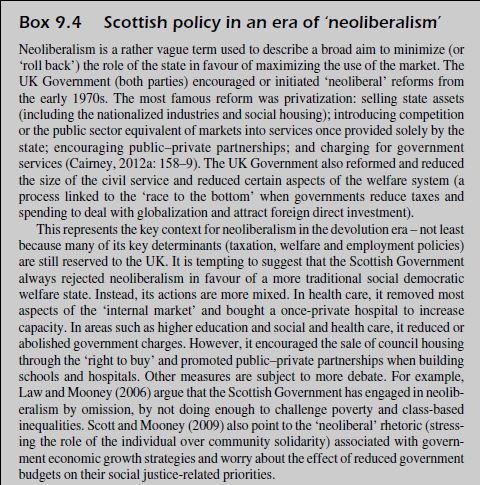
When studying the role of parliament in the UK, it is common to argue that it is more powerful than you think. If the dominant narrative is that parliaments are peripheral to the policy process, then let’s show you what is wrong with that narrative.
I’ve done it myself several times (e.g. this article and this book pp104-7), partly because it’s a good hook for publication (and partly because David Judge was my PhD supervisor*). However, when I discuss these issues with students, I tend to conclude that an influence score of more-than-zero is still a low score. It’s a bit like me telling people: ‘I look pasty, but I can run faster than you think’.
I say this after reading Russell, Gover, and Wollter’s (2015) excellent empirical analysis of Westminster’s influence over the past decade. It is ‘more influential than is widely recognised’, but what does that really mean? Let’s break down (what I take to be) the article’s 3 key points:
- The non-influential argument is untested empirically. This is a good way to justify Russell et al’s empirical work, but I think it’s a bit misleading. I think there is a lot of empirical work on policymaking out there which fails to pick up on any Westminster influence whatsoever. For example, in a lot of my interview research, it has not occurred to participants (including interest groups and civil servants) to mention the role of Westminster unprompted because it is so far down the list of relevant factors.
- The vagaries of the bill process give a misleading picture of low MP influence. When we study the legislative amendment process we find that the majority of successful government amendments are innocuous (exaggerating its success) and many amendments by MPs are designed to prompt debate, not succeed (exaggerating their failure). True. This is partly because, by the time a bill gets to Parliament, it is already a draft Act. The government has little interest in changing something already negotiated in detail with interested groups, and MPs are often looking to make points or seek clarity. Yet, for me, this clarification does little to accentuate parliamentary influence. Rather, it warns against the conclusion of non-influence using misleading measures (not the same thing as demonstrating influence).
- To gauge parliamentary influence you need measures which take ‘anticipated reactions’ into account. The government’s bill teams take great care to anticipate parliamentary reaction to bills, and produce draft legislation accordingly. Further, much government legislation is prompted by MPs (via, for example, committee reports and MP bills). Both of these points are important, but they remain partial because government actions are prompted by 101 things. We know that ministers and civil servants take Parliament into account in many cases, but in how many cases can we say that parliamentary influence is decisive or near the top of the list of most important factors? This question is explored in more depth in Russell and Cowley’s excellent article, but still to challenge the idea that Parliament is completely unimportant. We are still left with the argument: ‘if you think Westminster’s is really unimportant, Westminster is more powerful than you think’.
Where is the public policy analysis?
Russell and Cowley aim to ‘adopt a public policy lens, asking which parliamentary actors and processes exert influence, and at what policy stage(s)’. Yet, they cite almost none of the contemporary public policy literature (not even Jordan/ Richardson’s books after 1979, one of which engages with post-1979 developments).
For me, the value that you’d expect public policy analysis to add relates to its range of perspectives. A focus on networks was often to highlight the limits to ministerial as well as parliamentary power, since the state is so large that elites have to delegate most policymaking to other people, and can only keep track of a small proportion of government activity. Further, a focus on ‘street level’ actors and organisations further accentuates the sense that government policy is often delivered by routine, with a tendency for ministers and parliamentarians to pay attention to a tiny part of that activity. Perhaps most importantly, the contemporary literature tends to highlight the problems with a focus on stages to describe how policy is made. Or, if you are really keen, there is a discussion by Rod Rhodes and colleagues of the extent to which politicians maintain the fiction of the Westminster model of government, which can affect how they describe the role of Parliament and the importance of traditional forms of accountability.
I think that this kind of discussion informs the empirical analysis: if you ‘zoom in’ to look for evidence of (ministerial or) parliamentary influence you will find some. However, if you are adopting a ‘public policy lens’, it seems worthwhile to also ‘zoom out’ and consider how this evidence connects to the wider public policy literature. A focus primarily on Richardson/ Jordan as the classic 1979 text, then King/ Crewe 2013 as something more up to date, only seems valuable if one wants to stick it to the older generation without engaging with more thoughtful or empirical analysis.
Where do we go from here?
If you are interested in these arguments, you should follow ‘politicsphd’, who is working in depth on the issues as they relate to the Scottish Parliament’s bill process. He has some points which are directly relevant to Westminster analysis, including:
- We need more measures of influence. For example, we need to measure the overall effect of amendments rather than rely on counting substantive amendments (e.g. by comparing the bills before and after submission);
- We need to go beyond vague classifications of legislatures. We should focus more on important variations in parliamentary influence, on a bill-by-bill basis, rather than focusing primarily on an often misleading gauge of overall influence according to some bills which may or may not be representative.
My argument is simpler and based on the application of ‘bounded rationality’ to legislatures such as Westminster:
- Actors like MPs and MSPs only have the ability to pay attention to a tiny proportion of the issues processed by governments. So, they promote few to the top of their agenda and ignore the rest. They engage in ‘serial processing’: considering one issue at a time.
- Elected policymakers partly overcome this problem of serial processing by overseeing ‘parallel processing’ within government. A government breaks down policymaking into a huge number of discrete issues processed in different parts of the organisation. British parliaments tend not to have the resources to perform a similar role or keep up with the policy process in British government.
- So, you might expect the parliamentary equivalent of ‘punctuated equilibrium’: a tendency for parliaments to focus intensely on a small number of issues (with the potential for significant influence) at the expense of the vast majority of others.
In other words, think of parliamentary influence in terms of two sides of the same coin: if you identify influence in some areas, recognise the limited influence in most others.
For more of that sort of argument, see Key policy theories and concepts in 1000 words.
————–
*In my first year as a politics undergraduate I learned that Westminster was only important to the tourist trade (my lecturer was Jeremy Richardson). In my 3rd year I learned that Richardson and Jordan were quite wrong (my lecturer was David Judge). In my 4th year I learned that policy networks were at the heart of explanation and that Parliament rarely featured (David Marsh). During my PhD on networks I put in a chapter on Parliament – CHAPTER_3 – to try to please David Judge. I worked briefly for Mark Shephard and we made the ‘more influential than you think’ case for the Scottish Parliament. Then I went full circle by working closely at Aberdeen with Grant Jordan. I now talk a lot about bounded rationality, which is at the heart of my explanation for limited parliamentary influence: MPs/ MSPs don’t have the resources to be particularly influential.



















